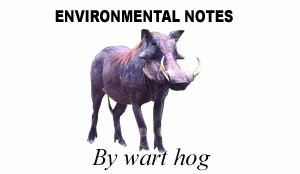 Wart hog was invited to a consultancy inceptions meeting which was held at Tecla Lodge on 20th July 2016 here in Lusaka, the Government of Republic Zambia through the GEF V project with the support from UNDP have engaged consultants to review the law enforcement system in the forestry and wildlife subsectors and will then come up with the strategy for improved management effectiveness and revenue generation in the Kafue and West Lunga National Park.
Wart hog was invited to a consultancy inceptions meeting which was held at Tecla Lodge on 20th July 2016 here in Lusaka, the Government of Republic Zambia through the GEF V project with the support from UNDP have engaged consultants to review the law enforcement system in the forestry and wildlife subsectors and will then come up with the strategy for improved management effectiveness and revenue generation in the Kafue and West Lunga National Park.
Looking at this what comes to Wart hog’s mind is the protection of our biodiversity or the protected areas. From the consultants methodologies shared it’s clear that our traditional leaders will be part of this process including a political will in order to achieve the needs in Kafue and west Lunga National park.
Protected areas are an extremely important part of programmes to conserve biodiversity and ecosystems, especially for sensitive habitats. Recent assessments have shown that at the global and regional scales, the existence of current PAs, while essential, is not sufficient for conservation of the full range of biodiversity.
Protected areas need to be better located, designed, and managed to deal with problems like lack of representativeness, impacts of human settlement within protected areas, illegal harvesting of plants and animals, unsustainable tourism, impacts of invasive alien species, and vulnerability to global change.
Freshwater ecosystems are even less well protected than terrestrial systems, leading to increasing efforts to expand PAs in these biomes. Efforts to expand marine protected areas are also spurred by strong evidence of positive synergies between conservation within PAs and sustainable use immediately outside their boundaries. However, protected area management poses special challenges, as enforcement is difficult and much of the world’s oceans lie outside national jurisdictions.
Based on a survey of management effectiveness of a sample of nearly 200 protected areas in 34 countries, only 12 per cent were found to have implemented an approved management plan. The assessment concluded that PA design, legal establishment, boundary demarcation, resource inventory, and objective setting were relatively well addressed.
But management planning, monitoring and evaluation, and budgets for security and law enforcement were generally weak among the surveyed areas. Moreover, the “paper park” problem remains, whereby geographic areas may be labeled as some category of protected area but not achieve the promised form of management.
Protected areas may contribute to poverty where rural people are excluded from resources that have traditionally supported their well-being. However, PAs can contribute to improved livelihoods when they are managed to benefit local people. Relations with local people should be addressed more effectively through participatory consultation and planning.
One possible strategy is to promote the broader use of IUCN protected areas management categories. Success depends on a collaborative management approach between government and stakeholders, an adaptive approach that tests options in the field, comprehensive monitoring that provides information on management success or failure, and empowerment of local communities through an open and transparent system that clarifies access and ownership of resources.
Success of protected areas as a response to biodiversity loss requires better site selection and incorporation of regional trade-offs to avoid some ecosystems from being poorly represented while others are overrepresented. Success of PAs depends on adequate legislation and management, sufficient resources, better integration with the wider region surrounding protected areas, and expanded stakeholder engagement.
Moreover, representation and management targets and performance indicators work best when they go beyond measuring the total area apparently protected. Indicators of percent-area coverage of PAs, as associated with the Millennium Development Goals and other targets, for example, only provide a broad indication of the actual extent of protection afforded by PA systems, but regional and national-level planning requires targets that take into account trade-offs and synergies with other ecosystem services.
Protected area design and management will need to take into account the impacts of climate change. The impacts of climate change will increase the risk of extinctions of certain species and change the nature of ecosystems.
Today’s species conservation plans may incorporate adaptation and mitigation aspects for this threat, drawing on existing tools to help assess species’ vulnerability to climate change. Corridors and other habitat design aspects to give flexibility to protected areas are effective precautionary strategies. Improved management of habitat corridors and production ecosystems between protected areas will help biodiversity adapt to changing conditions.
Wildlife & Environmental Conservation Society of Zambia, P.O. Box 30255, Lusaka, Zambia.
Telefax: 260-211-251630, Cell: 0977-780770
E-mail: wecsz@coppernet.zm






